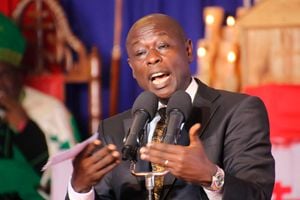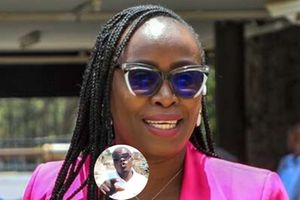Scratch your heads no more; here’s the hair ‘Naturalistas’ lingo

A woman sporting natural hair.
If you are a man who has a “Naturalista” in his life, we need to talk. It is entirely possible you
have felt like an intruder stumbling across a sacred ritual each time you find the woman in
your life doing something with or to her hair. Maybe you have wanted to ask questions. It is likely you have reached out and touched this hair, but this left you with even less understanding of it.
After all, it really is just like your own hair, right? Wrong.
Naturalistas can, and do, wear weaves and still have natural hair. Women can straighten their hair and still be Naturalistas. There are no limitations to the woman with magical hair that grows both longer, shorter or thicker depending on its state. Naturalistas are not exempted from wearing 28-inch weaves. We like our hair the way we like it.
And, no matter what India Arie sings, hair is a large part of who we are.
Being natural is like speaking a unique language. It comes with its own lingo. For instance, if a Naturalista says she will be washing her hair on a Saturday night so she can’t come out and play, believe us when we tell you it is an involved process. Here goes the Naturalista lingo.
Wash day: This is that slice of time in a Naturalista’s life where either two things happen.
One, she questions why she is a Naturalista, or she takes pride in this form of self-expression. Wash day could take anything from two to five hours, depending on whether she prefers rice water and aloe vera, or if she’s using store-bought treatment. Wash day usually starts well before the actual day. Which is why you must not come between a Naturalista and her wash day. She could prepare potions and lotions for the days before, or, prep herself on the actual day.
Edges: baby hair.
No-poo: A process that involves cleaning the hair with baking soda and vinegar instead of shampoo. It is ill-advised, but like many a thing about natural hair, it is an urban myth that refuses to die.
Co-wash: Hair conditioners are what Sta-Soft is to fabrics. Now, this is not advocated for, but co-wash is using your conditioner as shampoo. This is not to be confused with no-poo.
Conditioner: A thick product so filled with moisture it instantaneously softens the hair when wet. It is also a detangling tool because detangling can be a dangerous process if not done right. With this product, our hair is soft and smooth.
Sulphate-free: When a woman washes her hair until it squeaks, she has used something with sulphates in it. Sulphates are like little bugs inside the shampoo that make it oh so sudsy and fun to play with when washing the hair.
Clarifying shampoo: You’re probably wondering why I am mentioning this after you’ve read about sulphates. This is different. How? Well, for one thing, after we have styled our hair with products for a while, there is all this product build-up. It weighs the hair down, making it look slightly dull. If you can’t tell the difference between pre-clarified and clarified hair, do not panic. No one can. Not really. But this shampoo for some reason cleans the hair thoroughly. It is also only used once or twice a month.
Detangling: When we undo our hair, or after washing it, it can very easily turn into a bit of a mess. Detangling is the process of returning our hair to something similar to what you’ve known. It softens, and this is literally the only time in our lives you will be able to run your fingers through our hair. Detangling can be done with the fingers, which is painstakingly slow and calls for a lot of sighing and arm resting. It can be done with a comb, where we take chunks of hair and gently try not to hack our way through it, or we could do it with a Felicia
Leatherwood detangling brush. It’s a special kind of bendy plastic brush. If she has it, you
know.
Kinky: This doesn’t mean what you think it does. It means hair that is tight, curly and coily. It is sometimes also referred to as ‘nappy.’ Non-Black people are not allowed to say our hair is ‘nappy.’ We can say it. It’s our prerogative.
Lace-front: Again, not what you’re thinking. This is a very popular type of wig because it hides the hair, making the wig look less fake. It comes with its own invisible hairline, and looks more natural than a lot of the wigs you may have seen in the past. Let’s just say African Americans on TV helped with this one.
Split ends: This is basically damaged hair. This kind of hair is so dry and brittle, the tips of a strand has splayed itself open and looks like miniature tree branches.
Dusting: Lightly trimming the hair on top. It may or may not involve the cutting of split ends. It is a light trim all over natural hair. Dusting aids hair growth, leaving your scalp with only a healthy head of hair.
Protective hairstyle: Any hairdo that gets your natural hair out of the way of manipulation such as braids, weaves, and wigs. Referred to as such because they tuck in the ends of your air, and is said to speed up the process of hair growth. Every so often, a woman will get a protective hairstyle.
Sodium lauryl sulfate/ sulphates aka SLS: This is an ingredient in shampoos that strips the hair of its oils, natural and otherwise, as it cleans the hair. It is considered to be really drying to African hair. But, it also depends on who you ask. There are hair professionals who are SLS advocates stating that without it, hair doesn’t really get clean. It is a riveting conversation if you read about it. Just never be a know-it-all.
Jamaican black castor oil: It is exactly what it says it is. Someone said it was black hair magic. It was repeated until we believed it. Now it’s in pretty much every kind of hair product.
Nappyversary: A celebration of when you decided to go natural. It may be the result of the big chop -- the cutting of relaxed hair.
Natural hair: This can easily be considered obvious, but you would be surprised at the hair wars around this. Natural hair is hair the way it grows out of your scalp, with its born-this-way texture.
Shea butter: An ingredient so powerful, it could be the single most important moisturiser for natural hair. It is thick, creamy and is found in both East and West Africa. It is perfect for the skin too, giving it a lush soft sheen. Consider yourself introduced to the basics with this introduction. If you want to know more, don’t hesitate to reach out. Even Naturalistas still ask ‘what does that do?’ questions.





